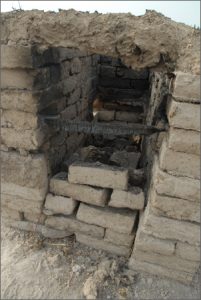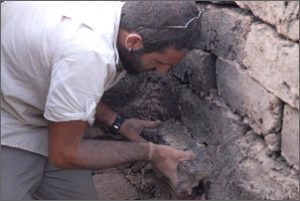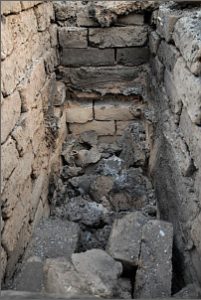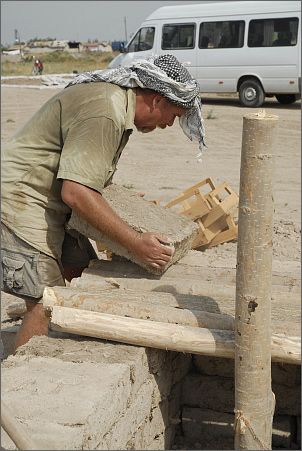In order to observe the affects of fire on mudbrick construction, several burning experiments simulated different levels of firing. Often, burnt buildings, burnt building materials, and burnt debris levels are found during excavations, not only at Tell Atchana, but at any site where mudbrick was used as the dominant construction material, such as Kültepe, Acemhöyük, Kinet Höyük, and Ilipinar Höyük. This debris can vary between light brown, orange, red, and pink-red, depending on the temperature of the fire and the availability of oxygen during the burning. In our the burning experiment, a domestic house model was reconstructed and burned.
BURN THE HOUSE DOWN

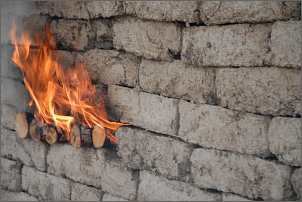
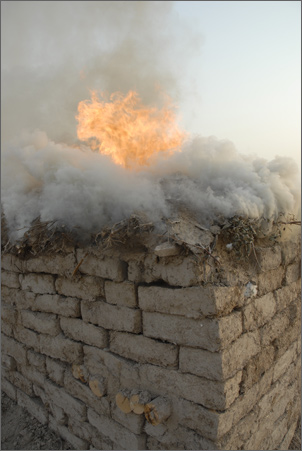
In this burning experiment, we built a small mudbrick room, filled it with different fuel, and burned it down. The idea was to get an impression of the effects of a ‘domestic’ fire. No large quantities of oil were used to provide additional heat, as might have been the case in the palace fires. Materials that could be expected to be present in an ancient house were collected and placed inside, though no extra fuel was added during the burning process. After the burning, we examined the colors of the bricks and the way building elements had collapsed. The first hour of the fire was filmed, and many photos were taken. The experiment was possible thanks to the previous experimental archaeology projects which targeted traditional building methods, such as the production of over 3000 mudbricks.
Of this pile of ready bricks, we used 168 to build the house, with 22 poplar posts used as a framework, as observed in the Alalakh palaces. No mud-mortar was used between the brick masonry (a technique called dry walling), because we judged that it would take too long to dry the whole structure if such mortar were used. The ends of the framework posts were left sticking out of the wall on both sides; on the west side, nothing was done to them, and some open spaces occurred between their ends, and on the east side, these open spaces were filled with mud plaster.
The room had a small suspended shelf on the north side made of six posts, placed 53 cm above the ground level. The top was plastered with a layer of mud plaster made of mud with heavy straw tempering. At the time of the fire, this plaster was not yet entirely dry. Two vessels were placed here: in the northwest corner, a small, empty jar, and in the front and middle, an open-mouthed pot filled with olive oil. Next to the shelf, a vertical post was dug into the ground and attached to the surface with a mud plaster joint. The east wall above the shelf was plastered with the mud plaster, and this plaster stopped in a straight vertical line in the middle of this wall.
The room’s entrance was a low open doorway. The roof was a mono-pitched roof, because the west wall was one brick higher than the east wall. Six posts were placed between these two parallel walls. The open space between these posts was covered by thin, small wooden planks, and a layer of dead plant stems were placed over these planks, substituting for reeds. This was all then covered with a layer of mud plaster. The west side of the floor had a pile of dry, thin wood, and a large number of cow dung pieces were placed along the east side under the shelf. Dried cow dung has been in use for millennia and is used as the traditional fuel in areas with a dry, harsh climate. Finally, the room was filled with dry stems of cotton plants, more dung was placed near the doorway, and the door was partially blocked with a few courses of mudbrick.
On the evening of a warm and almost windless day, the fire was lit at 18.29. After an initially slow start, it was soon raging out of control. After a few moments, smoke starting escaping through the roof plaster. After about 3 minutes and 20 seconds, the fire penetrated the roof, and flames ate a constantly expanding hole in it. The mudbricks blocking the doorway started to burn and gradually collapsed completely at 19.01.
In about one hour, everything that was stored in the house had burnt away, except for the shelf and the pile of dung below it. This became the center of the burning for a long time. The beams of the shelf became thinner and thinner, leaving hollow beam impressions, similar to examples founds at sites like Ilipinar and Karatas. The shelf collapsed within two hours, and the floor collapsed after breaking in the middle. The next day, 23 hours after the start of the fire, the layers inside the building were still very warm and smoldering at some points. Although ash formed the bulk of the room fill, almost no charcoal could be found, confirming the total absence of charcoal in the burnt houses of Phase VI at Ilipinar.
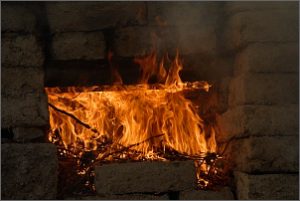
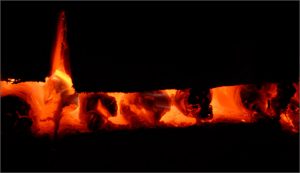
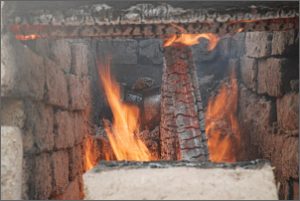
The early collapse of the roof resulted in a decrease in the fire’s temperature. The durability of poplar is low, and it does not include a high amount of resin that would increase the temperature. Nothing remained of the beams on the ground, the beams of the shelf, or the standing posts. The two vessels on the shelf both survived the initial collapse. However, the vessel that had contained the oil had become very brittle and was probably cracked internally: when lifted from the debris, it suddenly fell apart. The other vessel that had been empty showed no negative effects, though both vessels were discolored, changing from reddish buff to a grey-black tone. The empty jar was a ‘real’ vessel for daily use and was of a heavier fabric than the wider, open decorative type of pot which contained the olive oil.
Most of the bricks that were located above the shelf or in other parts of the room were black with smoke and soot or were a grayish-pinkish tone. No heavy burning effects were visible in these wall segments. The walls that were located below the suspended surface with its seven wooden beams and the pile of dung was pinkish-reddish in color. The burning effects did not penetrate very deep into the mudbricks, which were a reddish color on the exposed outside but were reduced to black inside the brick, followed by it natural colors. The bricks became very brittle and broke easily when lifted. The plaster layer on the east wall became very hard and was difficult to remove from the standing brick wall.
A simulated, 2 hour domestic fire in a heavily packed room with good oxidizing conditions did not produce the effects found at sites like Kültepe, Acemhöyük, Kinet Höyük, and Alalakh. Although some of these effects were present to a slight degree, they were not comparable to the heavily liquefied and vitrified state of these sites. Different wood types, storage materials, burning durations, and maybe different weather conditions, like high winds, may yield different results.
